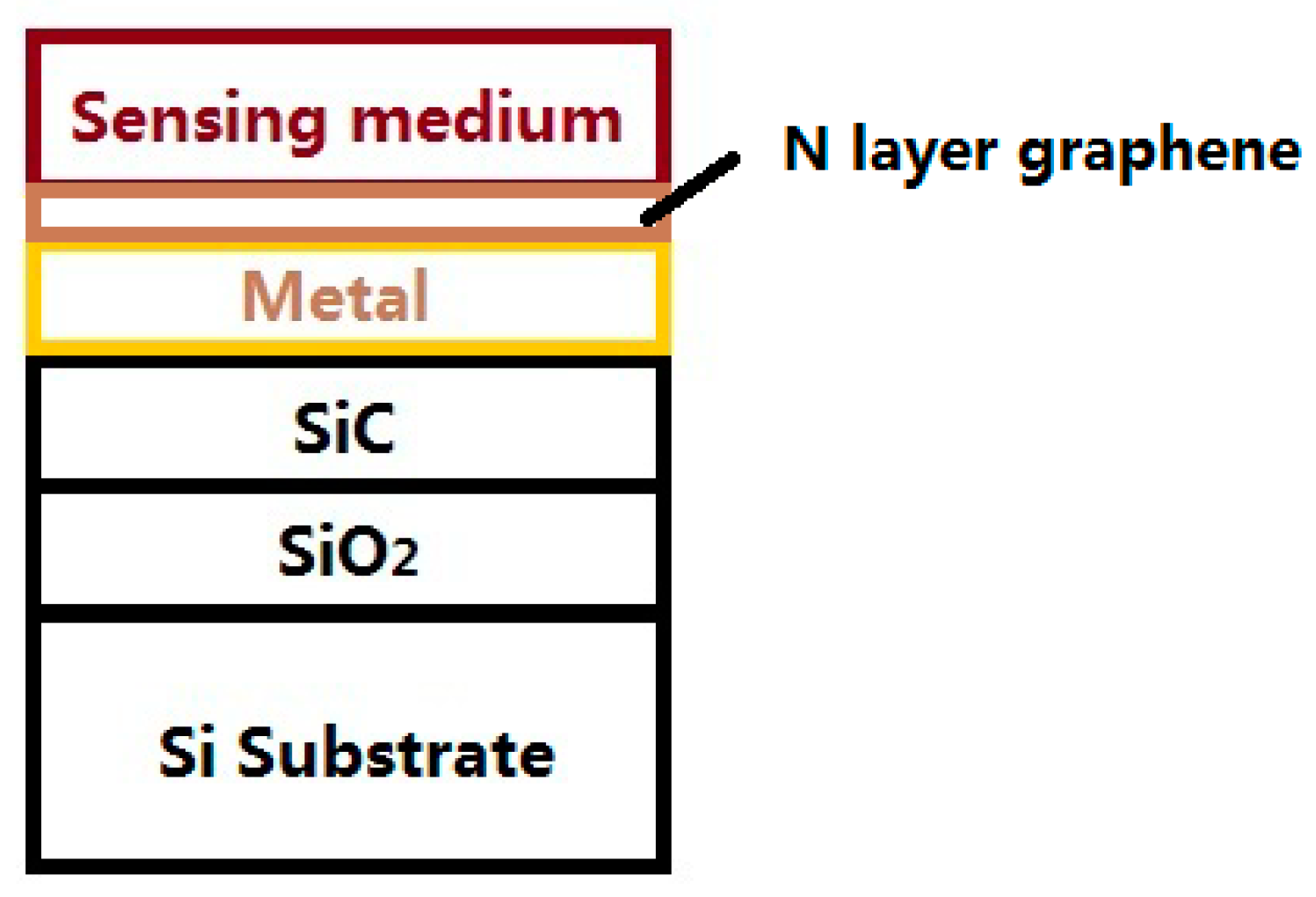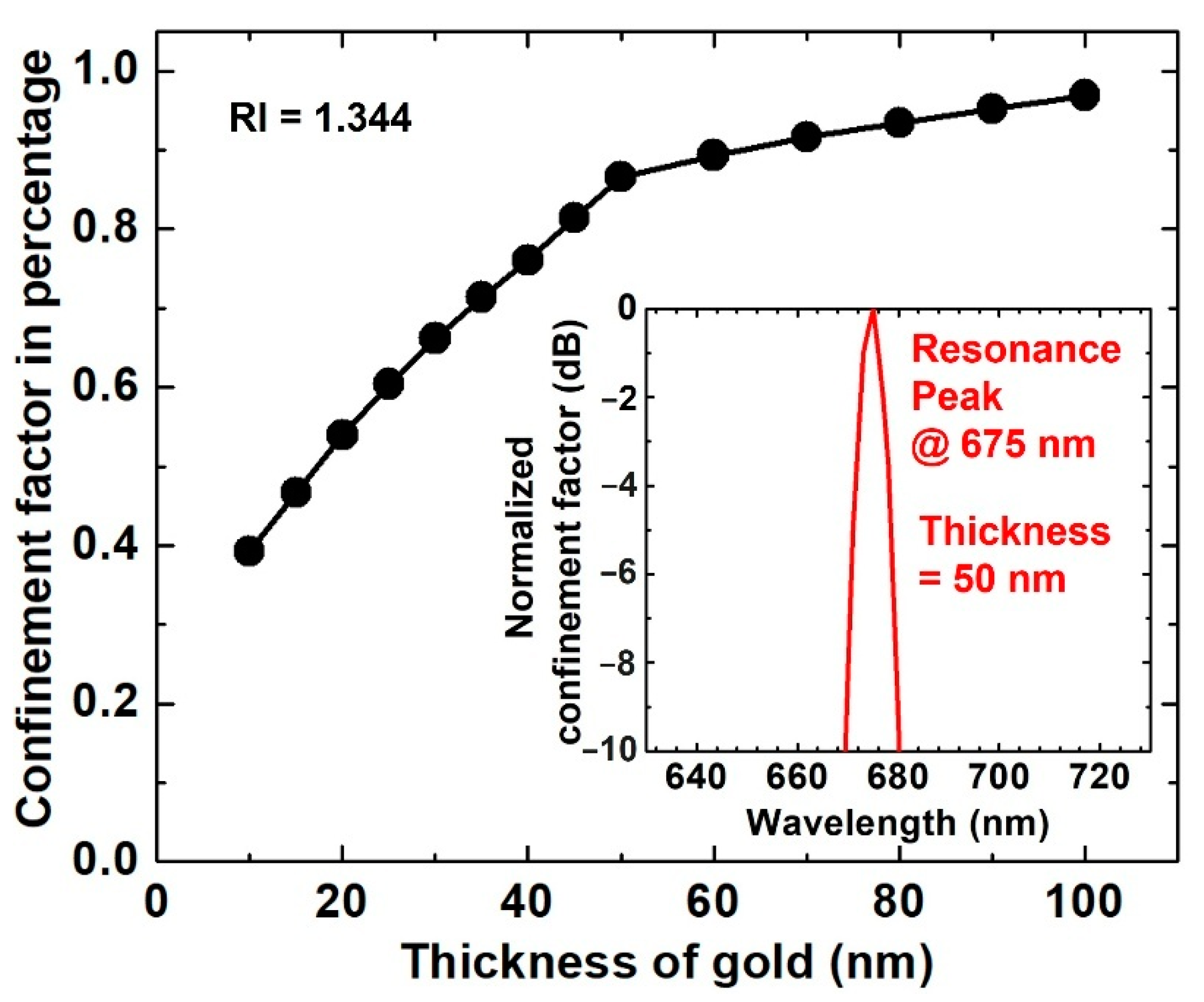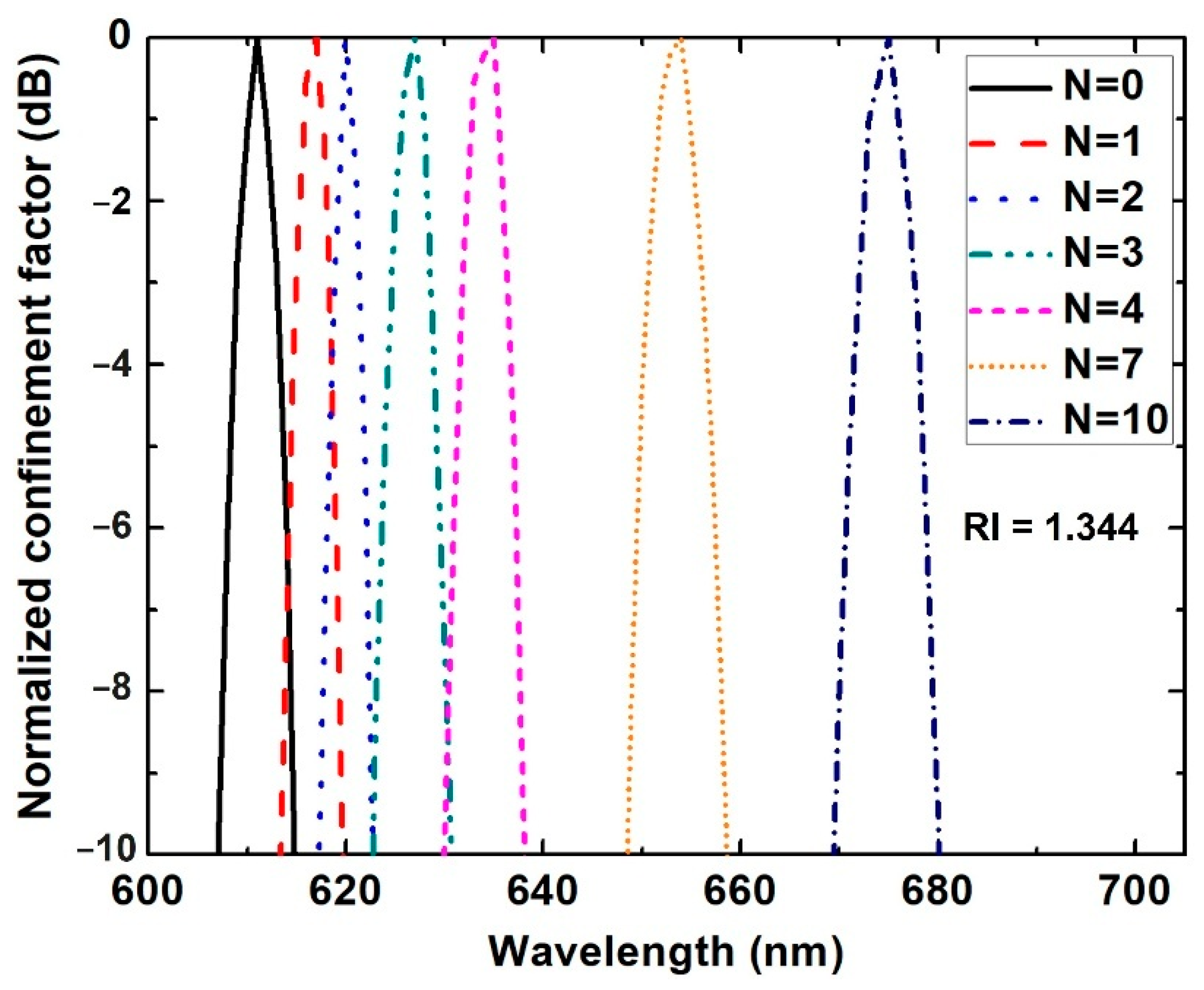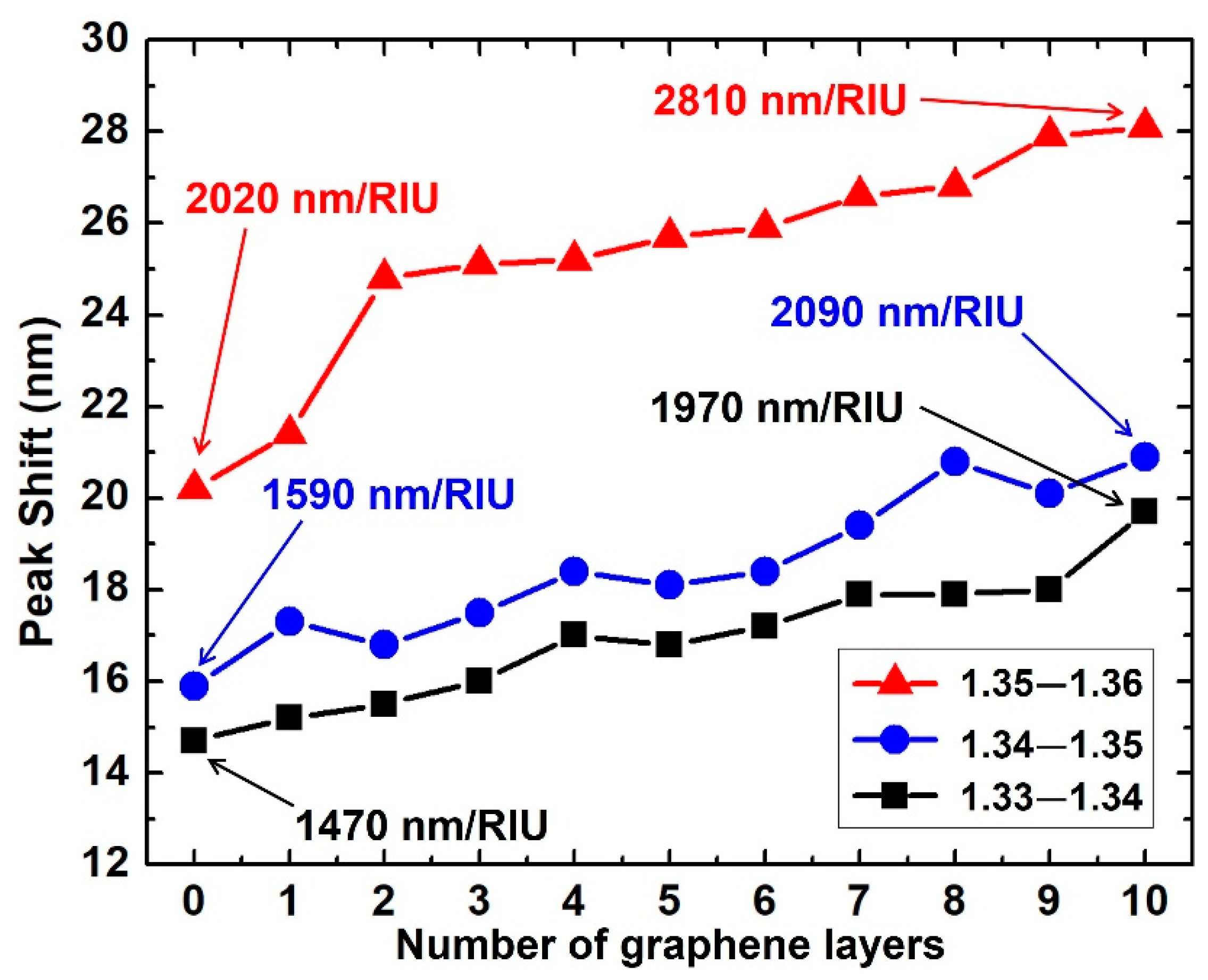Numerical Study of Graphene/Au/SiC Waveguide-Based Surface Plasmon Resonance Sensor
Abstract
1. Introduction
2. Design and Methods
3. Results and Discussion
4. Conclusions
Author Contributions
Funding
Institutional Review Board Statement
Informed Consent Statement
Data Availability Statement
Acknowledgments
Conflicts of Interest
References
- Homola, J. Surface Plasmon Resonance Sensors for Detection of Chemical and Biological Species. Chem. Rev. 2008, 108, 462–493. [Google Scholar] [CrossRef] [PubMed]
- Dudak, F.C.; Boyaci, I.H. Rapid and Label-Free Bacteria Detection by Surface Plasmon Resonance (SPR) Biosensors. J. Biotechnol. 2009, 4, 1003–1011. [Google Scholar] [CrossRef] [PubMed]
- Homola, J. Present and Future of Surface Plasmon Resonance Biosensors. Anal. Bioanal. Chem. 2003, 377, 528–539. [Google Scholar] [CrossRef]
- Liedberg, B.; Nylander, C.; Lunström, I. Surface Plasmon Resonance for Gas Detection and Biosensing. Sens. Actuator 1983, 4, 299–304. [Google Scholar] [CrossRef]
- Bai, H.; Wang, R.; Hargis, B.; Lu, H.; Li, Y. A SPR Aptasensor for Detection of Avian Influenza Virus H5N1. Sensors 2012, 12, 12506–12518. [Google Scholar] [CrossRef]
- Raether, H. Surface Plasmons on Smooth Surface. In Surface Plasmons on Smooth and Rough Surfaces and on Gratings; Springer: Berlin/Heidelberg, Germany, 1988; p. 19. [Google Scholar]
- Kooyman, R.P.H.; Kolkman, H.; van Gent, J.; Greve, J. Surface Plasmon Resonance Immunosensors: Sensitivity Considerations. Anal. Chim. Acta 1988, 213, 35–45. [Google Scholar] [CrossRef]
- Lawrence, C.R.; Geddes, N.J.; Furlong, D.N. Surface Plasmon Resonance Studies of Immunoreactions Utilizing Disposable Diffraction Gratings. Biosens. Bioelectron. 1996, 11, 389–400. [Google Scholar] [CrossRef]
- Debackere, P.; Scheerlinck, S.; Bienstman, P.; Baets, R. Surface Plasmon Interferometer in Silicon-On-Insulator: Novel Concept for an Integrated Biosensor. Opt. Express 2006, 14, 7063–7072. [Google Scholar] [CrossRef]
- Yimit, A.; Rossberg, A.G.; Amemiya, T.; Itoh, K. Thin Film Composite Optical Waveguides for Sensor Applications: A Review. Talanta 2005, 65, 1102–1109. [Google Scholar] [CrossRef]
- Zourob, M.; Lakhtakia, A. Plasmonic-Waveguide Sensors. In Optical Guided-Wave Chemical and Biosensors; Springer: Berlin/Heidelberg, Germany, 2010; pp. 133–154. [Google Scholar]
- Koch, T.L.; Koren, U. Semiconductor Photonic Integrated Circuits. IEEE J. Quantum Electron. 1991, 27, 641–653. [Google Scholar] [CrossRef]
- Johnsson, B.; Löfås, S.; Lindquist, G. Immobilization of Proteins to a Carboxymethyldextran-Modified Gold Surface for Biospecific Interaction Analysis in Surface Plasmon Resonance Sensors. Anal. Biochem. 1991, 198, 268–277. [Google Scholar] [CrossRef]
- Sherry, L.J.; Chang, S.H.; Schatz, G.C.; Van Duyne, R.P. Localized Surface Plasmon Resonance Spectroscopy of Single Silver Nanocubes. Nano Lett. 2005, 5, 2034–2038. [Google Scholar] [CrossRef] [PubMed]
- Chan, G.H.; Zhao, J.; Schatz, G.C.; Van Duyne, R.P. Localized Surface Plasmon Resonance Spectroscopy of Triangular Aluminum Nanoparticles. J. Phys. Chem. C 2008, 112, 13958–13963. [Google Scholar] [CrossRef]
- Stewart, M.E.; Anderton, C.R.; Thompson, L.B.; Maria, J.; Gray, S.K.; Rogers, J.A.; Nuzzo, R.G. Nanostructured Plasmonic Sensors. Chem. Rev. 2008, 108, 494–521. [Google Scholar] [CrossRef]
- Lee, K.L.; Lee, C.W.; Wang, W.S.; Wei, P.K. Sensitive Biosensor Array Using Surface Plasmon Resonance on Metallic Nanoslits. J. Biomed. Opt. 2007, 12, 044023. [Google Scholar] [CrossRef]
- Du, W.; Zhao, F. Silicon Carbide Based Surface Plasmon Resonance Waveguide Sensor With a Bimetallic Layer for Improved Sensitivity. Mater. Lett. 2017, 186, 224–226. [Google Scholar] [CrossRef]
- Du, W.; Zhao, F. Sensing Performance Study of SiC, A Wide Bandgap Semiconductor Material Platform for Surface Plasmon Resonance Sensor. J. Sens. 2015, 2015, 341369. [Google Scholar] [CrossRef]
- Du, W.; Chen, Z.B.; Zhao, F. Analysis of Single-Mode Optical Rib Waveguide in Silicon Carbide. Microw. Opt. Technol. Lett. 2013, 55, 2636–2640. [Google Scholar] [CrossRef]
- Song, B.; Li, D.; Qi, W.P.; Elstner, M.; Fan, C.H.; Fang, H.P. Graphene on Au(111): A Highly Conductive Material with Excellent Adsorption Properties for High-Resolution Bio/Nanodetection and Identification. ChemPhysChem 2010, 11, 585–589. [Google Scholar] [CrossRef]
- Wu, L.; Chu, H.S.; Koh, W.S.; Li, E.P. Highly Sensitive Graphene Biosensors Based on Surface Plasmon Resonance. Opt. Expressvol. 2010, 18, 14395–14400. [Google Scholar] [CrossRef]
- Chen, Z.; Fares, C.; Elhassani, R.; Ren, F.; Kim, M.; Hsu, S.; Clark, A.E.; Esquivel-Upshaw, J.F. Demonstration of SiO2/SiC based protective coating for dental ceramic prostheses. J. Am. Ceram. Soc. 2019, 102, 6591–6599. [Google Scholar] [CrossRef] [PubMed]
- Zhang, Y.; Zhang, L.; Zhou, C. Review of Chemical Vapor Deposition of Graphene and Related Applications. Acc. Chem. Res. 2013, 46, 2329–2339. [Google Scholar] [CrossRef]
- Du, W.; Zhao, F. Surface Plasmon Resonance Based Silicon Carbide Optical Waveguide. Mater. Lett. 2014, 115, 92–95. [Google Scholar] [CrossRef]
- Nair, R.R.; Blake, P.; Grigorenko, A.N.; Novoselov, K.S.; Booth, T.J.; Stauber, T.; Peres, N.M.R.; Geim, A.K. Fine Structure Constant Defines Visual Transparency of Graphene. Science 2008, 320, 1308. [Google Scholar] [CrossRef]
- Bruna, M.; Borini, S. Optical Constants of Graphene Layers in the Visible Range. Appl. Phys. Lett. 2009, 94, 031901. [Google Scholar] [CrossRef]
- Raether, H. Collection of the Dielectric Functions of Gold and Silver. In Surface Plasmons on Smooth and Rough Surfaces and on Gratings; Springer: Berlin/Heidelberg, Germany, 1988. [Google Scholar]
- Pandraud, G.; French, P.J.; Sarro, P.M. Fabrication and Characteristics of a PECVD SiC Evanescent Wave Optical Sensor. Sens. Actuat. A-Phys. 2008, 142, 61–66. [Google Scholar] [CrossRef]
- Tamir, T. Theory of Dielectric Waveguides. In Integrated Optics, 1st ed.; Springer: New York, NY, USA, 1975. [Google Scholar]
- Batrak, D.V.; Plisyuk, S.A. Applicability of the Effective Index Method for Simulating Ridge Optical Waveguides. Quantum Electron. 2006, 36, 349–352. [Google Scholar] [CrossRef]
- Nan, H.Y.; Chen, Z.Y.; Jiang, J.; Li, J.Q.; Zhao, W.W.; Ni, Z.H.; Gu, X.F.; Xiao, S.Q. The Effect of Graphene on Surface Plasmon Resonance of Metal Nanoparticles. Phys. Chem. Chem. Phys. 2018, 20, 25078–25084. [Google Scholar] [CrossRef] [PubMed]
- Jin, Y.L.; Chen, J.Y.; Xu, L.; Wang, P.N. Refractive Index Measurement for Biomaterial Samples by Total Internal Reflection. Phys. Med. Biol. 2006, 51, N371–N379. [Google Scholar] [CrossRef]
- Chuanga, T.L.; Weib, S.C.; Leec, S.Y.; Lin, C.W. A Polycarbonate Based Surface Plasmon Resonance Sensing Cartridge for High Sensitivity HBV Loop-Mediated Isothermal Amplification. Biosens. Bioelectron. 2012, 32, 89–95. [Google Scholar] [CrossRef]
- Hsieh, H.V.; Pfeiffer, Z.A.; Amiss, T.J.; Sherman, D.B.; Pitner, J.B. Direct Detection of Glucose by Surface Plasmon Resonance with Bacterial Glucose/Galactose-Binding Protein. Biosens. Bioelectron. 2004, 19, 653–660. [Google Scholar] [CrossRef]
- Singh, S.; Kaur, V. Photonic Crystal Fiber Sensor Based on Sensing Ring for Different Blood Components: Design and Analysis. In Proceedings of the Ninth International Conference on Ubiquitous and Future Networks (ICUFN), Milan, Italy, 4–7 July 2017. [Google Scholar]
- Zeni, L.; Perri, C.; Cennamo, N.; Arcadio, F.; D’Agostino, G.; Salmona, M.; Beeg, M.; Gobbi, M. A Portable Optical-Fibre-based Surface Plasmon Resonance Biosensor for the Detection of Therapeutic Antibodies in Human Serum. Sci. Rep. 2020, 10, 11154. [Google Scholar] [CrossRef] [PubMed]
- Loyez, M.; Lobry, M.; Hassan, E.M.; DeRosa, M.C.; Caucheteur, C.; Wattiez, R. HER2 Breast Cancer Biomarker Detection Using a Sandwich Optical Fiber Assay. Talanta 2021, 221, 121452. [Google Scholar] [CrossRef]
- Kong, L.X.; Chi, M.J.; Ren, C.; Ni, L.F.; Li, Z.; Zhang, Y.S. Micro-Lab on Tip: High-Performance Dual-Channel Surface Plasmon Resonance Sensor Integrated on Fiber-Optic End Facet. Sens. Actuators B Chem. 2022, 351, 130978. [Google Scholar] [CrossRef]





Publisher’s Note: MDPI stays neutral with regard to jurisdictional claims in published maps and institutional affiliations. |
© 2021 by the authors. Licensee MDPI, Basel, Switzerland. This article is an open access article distributed under the terms and conditions of the Creative Commons Attribution (CC BY) license (https://creativecommons.org/licenses/by/4.0/).
Share and Cite
Du, W.; Miller, L.; Zhao, F. Numerical Study of Graphene/Au/SiC Waveguide-Based Surface Plasmon Resonance Sensor. Biosensors 2021, 11, 455. https://doi.org/10.3390/bios11110455
Du W, Miller L, Zhao F. Numerical Study of Graphene/Au/SiC Waveguide-Based Surface Plasmon Resonance Sensor. Biosensors. 2021; 11(11):455. https://doi.org/10.3390/bios11110455
Chicago/Turabian StyleDu, Wei, Lucas Miller, and Feng Zhao. 2021. "Numerical Study of Graphene/Au/SiC Waveguide-Based Surface Plasmon Resonance Sensor" Biosensors 11, no. 11: 455. https://doi.org/10.3390/bios11110455
APA StyleDu, W., Miller, L., & Zhao, F. (2021). Numerical Study of Graphene/Au/SiC Waveguide-Based Surface Plasmon Resonance Sensor. Biosensors, 11(11), 455. https://doi.org/10.3390/bios11110455




